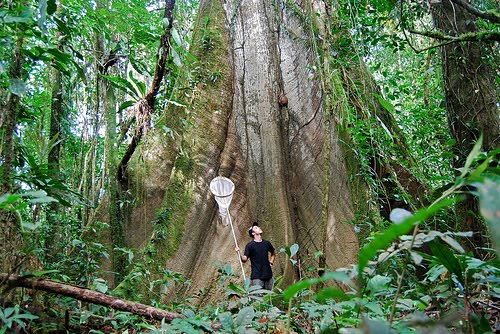Upon our arrival, we set out to survey the trails, searching for the best site to begin setting up traps. One of the trails seemed ideal, so we began putting traps up every 100 meters. Getting traps into the canopy is important, since many species do not descend to the ground and thus cannot be trapped there. So, we try to get them as high as possible, and this often turns into quite an ordeal. Using fishing weights, we throw the string over a branch, and ideally the weight falls right back with the string attached. Of course, it doesn't always go so smoothly, and it can be extremely frustrating to lose weights and strings to the tangle of leaves above. The effort is worth it though, as the traps produce some of the most amazing creatures imaginable from the poorly-studied rainforest canopy.
 |
| Traps, set at ground level (left), and high in the forest canopy (right). |
 |
| We use rotting fish to bait the traps. While the fish smells absolutely disgusting to us, butterflies can't seem to get enough. |
With the traps finally set, we began the more key task of measuring a number of ecological variables from the areas immediately surrounding the traps. These variables will hopefully give us a better insight into the factors that influence butterfly abundance and distribution, of which very little is known. A better understanding of patterns in abundance and distribution, in turn, will be important in conserving the most species possible using the limited resources available. I'll have more to say on that in future posts.

Good to see you are getting your hands dirty! Mmmm...fish.
ReplyDeleteSo I told you that I'm taking Stats this semester, right? That purple haired girl is in the class again and she's already asking questions. Arg.
Hope you're having fun out there!